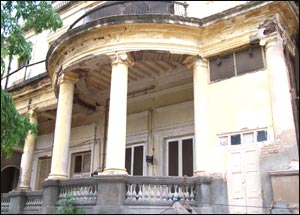»
Tourist Spots » Ashurkhanas Of HyderabadAshurkhanas Of Hyderabad

Deepa Menon / fullhyd.com
Joy can bring people together, but it's grief that binds them. For around ten days in March, Shia Muslims from all over the city seek each other out in houses of mourning - ashurkhanas - to share the memory of loss. And this loss is marked by the period of Moharram, a tribute to a martyr, Hazrat Imam Hussain, the grandson of the Prophet. This is a time of intense grieving, but because there is beauty even in pain, these haunts of sadness have been built with enormous love and care.
The city's oldest such monument is the Badshahi Ashurkhana, and its most immaculately guarded one is the Aza Khana-E-Zohra. The first one was built during the fag-end of the 16th century, but the second one is a mere baby in comparison, and will only complete its first century in the 2030s.
Ashurkhanas house alams, war relics that announce the identity of the ruler during a battle. The Badshahi Ashurkhana, with its ancient mosaics and colonnades, is one of the oldest imambaras of India, and sits opposite the famous Madina Hotel in Old City (a must-stop for biryani-lovers).
The Aza Khana-E-Zora is intricate, grand, and overlooks the once gushing river Musi. Domes sit large and peaceful on this rare, true representation of the Osmanian style of architecture. Sharp carvings and verses from the Quran cover the walls, and green and black is the unchanging motif.
One of Hyderabad's most precious heritage structures, the Aza Khana-E-Zohra is special not just because it wins the occasional national award, but because its caretakers are devoted to keeping it young. Its loveliness is not lost even after the season has rolled on.
The city's oldest such monument is the Badshahi Ashurkhana, and its most immaculately guarded one is the Aza Khana-E-Zohra. The first one was built during the fag-end of the 16th century, but the second one is a mere baby in comparison, and will only complete its first century in the 2030s.
Ashurkhanas house alams, war relics that announce the identity of the ruler during a battle. The Badshahi Ashurkhana, with its ancient mosaics and colonnades, is one of the oldest imambaras of India, and sits opposite the famous Madina Hotel in Old City (a must-stop for biryani-lovers).
The Aza Khana-E-Zora is intricate, grand, and overlooks the once gushing river Musi. Domes sit large and peaceful on this rare, true representation of the Osmanian style of architecture. Sharp carvings and verses from the Quran cover the walls, and green and black is the unchanging motif.
One of Hyderabad's most precious heritage structures, the Aza Khana-E-Zohra is special not just because it wins the occasional national award, but because its caretakers are devoted to keeping it young. Its loveliness is not lost even after the season has rolled on.
ASHURKHANAS OF HYDERABAD SNAPSHOT
-
Listed In
-
Address
-
Telephone
-
Distance3.1 km (Maps & Directions)
-
Year Started
-
Prices
-
Payment Option(s)
-
Closest Bus Stop
-
Closest MMTS Station
-
Add New Field:
EVENTS AT ASHURKHANAS OF HYDERABAD
There are no events at Ashurkhanas Of Hyderabad scheduled currently.
ASHURKHANAS OF HYDERABAD USER REVIEWS
Be the first to comment on Ashurkhanas Of Hyderabad! Just use the simple form below.
LEAVE A COMMENT
fullhyd.com has 700,000+ monthly visits. Tell Hyderabad what you feel about Ashurkhanas Of Hyderabad!
RELATED LISTINGS
Tankbund (2.3km)
Adjacent to Nehru Zoological Park, Bahadurpura (8.5km)
Near RBI, Adarshnagar (1.4km)
Pilot Raj Kumar Road, Gopal Nagar, Malkajgiri, Secunderabad (8.3km)
NH9, Vijayawada Highway, Vanasthalipuram
RELATED CATEGORIES
SEARCH YELLOW PAGES
Dissatisfied with the results? Report a problem or error, or add a listing.
ADVERTISEMENT
SHOUTBOX!
{{ todo.summary }}... expand »
{{ todo.text }}
« collapse
First | Prev |
1 2 3
{{current_page-1}} {{current_page}} {{current_page+1}}
{{last_page-2}} {{last_page-1}} {{last_page}}
| Next | Last
{{todos[0].name}}
{{todos[0].text}}
ADVERTISEMENT
This page was tagged for
malkajgiri hyderabad ashurkhana
malkajgiri ashoor khane
The Ashur Khanas of Hyderabad City
darrul shifa museum in hyderabad
aza khana bus stop